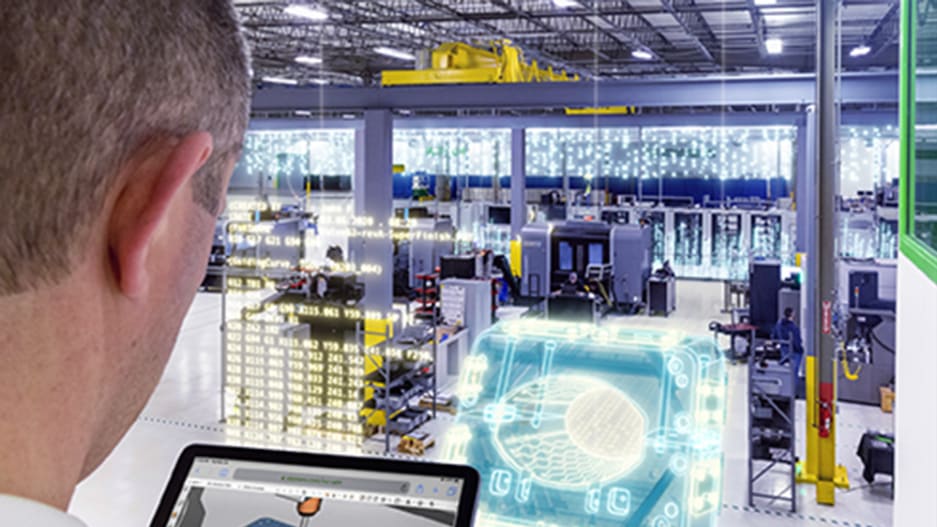
The pandemic tested many companies’ ability to pivot on a dime. Here’s how one business rapidly recalibrated to fill the medical-supply shortage.
Until last spring, the engineers at iMFLUX largely thought of themselves as the ones who make the machines that make so much of the stuff of everyday life. The company’s plastic injection moulds and systems have produced untold quantities of shampoo bottle caps, laundry-bead packages, and home-care devices for its owner and largest customer, Procter & Gamble. Each mold is a massive and massively complex one-of-a-kind steel apparatus designed to run without interruption for years. But as much of the U.S. began shutting down in March to curb the COVID-19 pandemic, America’s factories stilled, raising an unprecedented risk of cancelled orders—and an opportunity to reinvent the company on the fly.
“When COVID hit, it didn’t really scare us in terms of how we adapt,” recalls Dan Lumpkin, vice president of mold shop operations at iMFLUX, and a veteran of both Apple and P&G. Rather, he says, the questions turned to, “What do we have to stop?” and “Where do we have to shift production?”
This was in March when companies such as Ford and General Motors were pledging their assembly lines to make ventilators instead of V8 engines. While both automakers ultimately fulfilled their contracts to produce them by the tens of thousands, a wholesale retooling of American manufacturing never happened. One reason is that many manufacturers couldn’t be having long ago outsourced critical components to supply chains disrupted by China’s lockdowns early in the pandemic. Another is that firms’ most valuable assets—the know-how stored only in their workers’ heads—were stuck in quarantine.
“I’ve visited market leaders where the shop floor is run on pen and paper,” says Rene Wolf, senior vice president of manufacturing operations management software at Siemens Digital Industries Software. “I asked them, ‘What happens if a shift leader breaks a leg?’ The answer was the others would have to do double shifts. There was no Plan B—especially in a pandemic.”
Companies struggling to restart production after the initial wave passed faced another dilemma: how to bring those employees back to work safely. This could be done by social distancing and staggering shift changes, but redesigning assembly lines on the fly is nearly impossible to calculate if all you have to rely on his pen and paper.
THE ADVANTAGE OF A DIGITAL TWIN
iMFLUX was more fortunate than most manufacturers in several respects. One is that it was deemed “essential” in the crisis due to its customers ordering molds to produce home-cleaning packages and other germ-killing sanitary products. Another is that parent P&G—whose Cincinnati headquarters lies 30 miles south of iMFLUX’s plant in Hamilton, Ohio—provided all the hand sanitizer, masks, temperature screenings, and personal protective equipment (PPE) its employees would ever need.
It also had a “digital twin”—a complete simulation of its operations that executives could experiment with at home. “Companies with digital twins have been more successful during the pandemic because they can plan and monitor work remotely,” explains Zvi Feuer, senior vice president of manufacturing engineering software at Siemens Digital Industries Software. Some of Siemens’ customers have used theirs to schedule factory shifts that never overlap. In contrast, the company itself has gone a step further, using wearable sensors to plot routes through its factories, ensuring workers literally never cross paths.

In iMLUX’s case, having a digital twin meant speed. While other companies floundered to retool back in April, its teams were on Zoom calls with a client that makes dental swabs, strategizing how they could reconfigure their molds for COVID tests instead. “We were able to move quickly from becoming experts in designing swab molds to moving those designs into our manufacturing shop with minimal manual operations,” Lumpkin says. “We were able to build molds in as little as two weeks,” a 30%-50% savings in terms of time.
As the first wave of the pandemic reached its peak, iMFLUX used its digital twin to drop nearly everything and switch instantly to manufacturing molds for tests and PPE, initially on behalf of local and state hospitals, such as the Cleveland Clinic, and eventually at national scale for FEMA. Between making headbands for face shields and plastic caps for test vials, Lumpkin says it dawned on him that “this new world of diagnostics for COVID and even the common cold is here to stay.” The new challenge for iMFLUX is balancing the demands of loyal customers with a new line of business that is tragically still needed, all while delivering with the same quality, urgency, and service that they have established.
After the pandemic, Feuer expects the struggles that manufacturers faced will cause factories themselves to change. While much has been written about supply chains shrinking a few links, he believes the larger lesson has to do with agility, with production runs of millions pivoting to the platonic ideal of “a batch of one.”
“We’ll rethink what an optimal facility is,” Feuer says. “One that has enough space to grow and meet its targets, but also takes care of what truly matters—our people.”

Don’t hesitate to contact Thanh for advice on automation solutions for CAD / CAM / CAE / PLM / ERP / IT systems exclusively for SMEs.
Luu Phan Thanh (Tyler) Solutions Consultant at PLM Ecosystem Mobile +84 976 099 099
Web www.plmes.io Email tyler.luu@plmes.io
